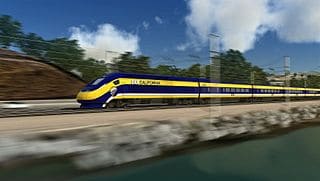This June 16th marks five years since construction on California’s statewide high-speed rail program first began.
There are now 4,000 laborers doing bullet-train-related building work in the Golden State’s Central Valley at over three dozen sites.
That level of commitment notwithstanding, there are those who think that they know what’s best regarding where yet-unspent dedicated project funds should go – in this particular instance on conventional commuter rail work elsewhere in state. We’re talking some $4.8 billion in funding.
But the San Joaquin Valley has a real problem and it has nothing to do with high-speed rail, its funding, identified routing or anything else: The Valley has the worst fine-particulate-matter in all of the U.S. and is the country’s second worst area for ozone or smog.
Since transportation is now the biggest contributor in not just the Valley but statewide where air-pollutant emissions are concerned, to allocate dollars to projects like widening highways in the name of combating transportation-sourced emissions is about as ridiculous as saying air pollution can’t cause harm to health.
Or, making the declaration that high-speed train service just is flat-out unneeded.
Based on what belief? That too few use it? That no one rides trains anymore? That motor vehicles and airplanes work just fine? What?!
High-speed rail has the potential to reduce energy usage; get significant numbers of travelers out of cars and airplanes; make all transportation modes safer; bring a better balance in the transportation sector; and most importantly, to bring further improvement to air quality in the Valley and state.
Or, that building highways is more cost-efficient than building high-speed railways.
The truth is, construction cost-efficiency wise, highways versus high-speed railways, the latter goes miles farther.
So, what if any advantages are there to redirecting California high-speed rail funds away from bullet-train-project work in the Valley to conventional passenger-rail expansion, improvement efforts elsewhere in state?
One huge disadvantage is the downsizing of the high-speed-rail-project effort in the Valley which means a likely loss in bullet-train-related jobs, fewer dollars injected into local economies directly tied to those job losses, an shorter usable operating segment or sector on which passenger trains would roll – 171 miles from Merced to Bakersfield reduced to 119 miles from Madera to Wasco and diesel train operation substituting for fully electrified service and, coupled with this, reduced maximum operating speeds from 220 mph down to 110-125 mph, the latter which would likely result in lower numbers of patrons riding train and potential lost revenue on account of that.
In addition, spreading out valuable Valley rail dollars siphoned off and going to other rail projects means that money would need to be shared among those, meaning, those dollars just won’t go as far as they would in being spent or used on one project only.
On the other hand, the assumption is that if dedicated Valley high-speed rail funds make their way to projects in both northern and southern California, then that money will go into lengthening sidings and improving other infrastructure, will be applied to additional rolling stock (the passenger cars and/or locomotives) acquisitions, if not hiring more operating personnel, etc.
One of the arguments for pulling dedicated high-speed rail money out of the Valley has to do with the presumed uncertainty surrounding the guaranteeing of a one-seat ride (or maybe more precisely the lack thereof) for a run between the Valley and Bay areas do to a significantly scaled-back program. However, with what is known as a “dual-mode” locomotive – one that uses electricity and diesel fuel – such can be employed to pull both electric trains in electrified and non-electric diesel-powered trains in non-electrified territories, respectively.
What’s more, an expanded Valley ridership could go a long ways toward capturing a greater market share prompted by a fast or faster-speed, more comfortable, safer, more reliable, less stressful/more hassle-/worry-free form of travel in the region known in California as the great Central Valley.
Keep those dedicated high-speed rail dollars exactly where they are and belong: in the Valley!
Image above: California High-Speed Rail Authority
– Alan Kandel


